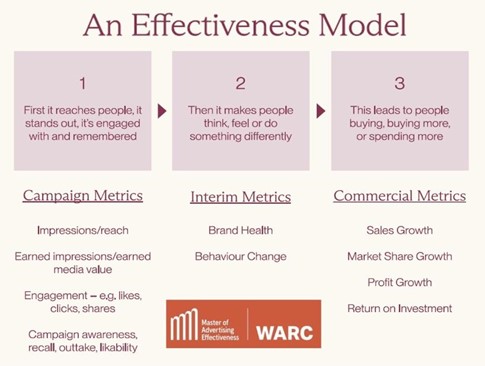Marketers don’t need more influencer metrics. They need better ways to connect social data to clients’ commercial goals to get the full picture on the effectiveness of influencer marketing.
Measurement is the biggest challenge with influencer marketing, according to WARC research in which 72% of marketers put it as their top bugbear. And it's no wonder, considering the avalanche of social metrics that come with the territory, making it difficult to separate the signal from the noise.
We’re learning how influencers contribute to brand building efforts as an increasingly central element of the marketing mix in both the short and long term.
We need better data points, not more. Metrics that capture what actually matters to the client's business and demonstrate how the work works.
1. Brand goals > social goals
Effectiveness starts with clarity in communication.
We need to move past the decades-old vanity metrics such as Earned Media Value that encourage clients to chase their tail in a bid to beat the competition. And start demonstrating how influencer campaigns are contributing towards actual brand and business goals.
Social metrics are a useful indicator for benchmarking past performance and those of your competitors. But, without showing how and why the campaign worked, we’re stuck in the shallows when demonstrating impact.
James Hurman’s three steps towards an effectiveness model are instructive here:

Wise businesses don’t stop at the first step. They evaluate performance against brand goals to assess whether the campaign has made people think, feel or do anything differently. Then they examine the impact on commercial metrics such as sales or market share growth.
Ultimately, we should hold influencer marketing accountable to the same standards as the rest of the media mix, using robust methodologies to determine the drivers of effectiveness across all three steps.
2. Establish the full chain of effects
Using creative diagnostic models that incorporate both attention and emotive tracking, and cross-platform Brand Lift studies, we can start to understand the link between the immediate impact of assets and shifts in longer-term brand health or perception as a result.
We are fortunate that there are several innovative platforms such as our partners at DAIVID and ThisThat, who are taking the specific challenge of measuring interim effects in influencer head on.
These advanced methodologies help us move beyond the ‘what’ to explain the ‘how’ and ‘why’ a campaign is working, which enables repeatable and scalable performance.
Drivers analysis then allows us to connect the dots, moving beyond our initial hunches to prove which specific short-term effects lead to longer-term ones down the line and build a comprehensive chain of effects model.
Critically this process also allows us to show influencers how they can make their own content more effective. They’re at the sharp end of producing content for brands but very rarely get the opportunity to learn what’s working from agencies.
3. Capture the long-term contribution
My final ask is to make sure we establish the long-term as well as short-term effects of influencer marketing.
Econometric modelling consistently shows influencers are effective at driving sales over the long term, but it's rarely thought of as a brand building channel.
In the influencer space ‘ROI’ is often used interchangeably as the aforementioned EMV rather than representing actual dollar returns on investment. However, an accurate Revenue or Profit Return on Investment is entirely achievable if you have robust historic data with enough natural variation.
Modelling creates the capability to isolate incremental sales effects, giving fair credit to both short and long-term contributions as well as the halo effect on other channels to drive combined synergies.
We’ve helped add influencer to existing multichannel econometric studies and have found it contributes significantly to revenue ROI. In a recent study for a major UK supermarket retailer client, influencer marketing was the top ROI performer of any channel, albeit from a smaller base of media spend.
Working with our partners Magic Numbers, we’re now able to create bespoke models to determine investment effectiveness curves, the optimum budget split between platforms, organic and paid activity and longer-term brand building effects.
Existing principles, new practices
By establishing a full effectiveness model, adding brand and commercial metrics to campaign metrics, and understanding which matter most, we can enhance our understanding of what works and why.
We’re learning how influencers contribute to brand building efforts as an increasingly central element of the marketing mix in both the short and long term.
It will be exciting to uncover and share more lessons in effectiveness across the industry as we move into the next phase of the influencer revolution.
Simon Harwood is Global Effectiveness Director at Billion Dollar Boy.
Reserve your space for the IPA Effectiveness Conference, 9 October
The opinions expressed here are those of the authors and were submitted in accordance with the IPA terms and conditions regarding the uploading and contribution of content to the IPA newsletters, IPA website, or other IPA media, and should not be interpreted as representing the opinion of the IPA.